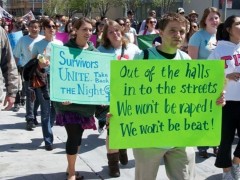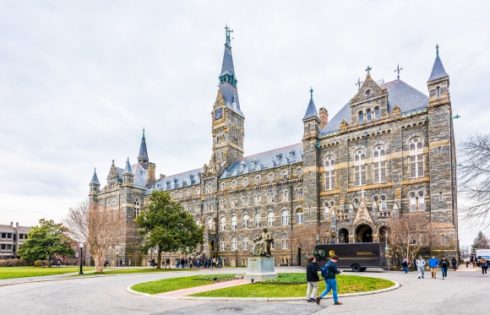
Brown University is in the midst of a pandemic.
All across America, colleges are cesspools of forcible sex crimes, including rape, which make the college campus one of the most dangerous places for women. According to many activists and politicians, one in every four women will experience rape or attempted rape in their college career. The problem is so severe that the federal government has intervened with the “Safe Campuses for Women” subsection in the Violence Against Women Act of 1993.
Brown itself has set up a 24-hour support line and has a full-time staff member dedicated to sexual assault prevention, along with numerous programs in Health Services. Popular campus events such as Consent Day and the recent One Billion Rising are dedicated to tackling the issue. Brown Daily Herald student newspaper opinion columnist Cara Newlon recently wrote in her piece “Don’t Rape” that despite the fact that one in four coeds are victims of rape or attempted rape, and that one in 12 male students commit these crimes, people are not talking about the subject enough.
So why is no one talking about this widespread issue? One reason is that it is not widespread. The campus rape pandemic seems to be a theory based upon poor survey methodology and repeated lies.
Newlon and numerous other activists make the bold claim that one in every four college women is a victim of rape or attempted rape. This number is astonishing and no doubt eyebrow-raising. To put it in perspective, in the nation’s most violent city (Detroit), the total violent crime rate was 2.1 percent in 2012. That figure includes murder, rape, assault, and robbery. If the one in four figure shouted at feminist rallies is correct, the nation is willingly sending its daughters to places with a violent crime rate several times that of the most dangerous city in the country.
The number seems even more dubious when compared to statistics put forth annually by the Bureau of Justice Statistics. The bureau interviews a random sampling of nearly 150,000 Americans about their criminal victimization, and in 2009 and 2010 they determined that the occurrence of rape of women was 0.23 percent and 0.21 percent, respectively. So with the figure in mind, it is prudent to see where the one in four statistic comes from.
In 1985, Ms. magazine published a study by Mary Koss in which she surveyed more than 3,000 college females nationwide asking them 10 questions about sexual violence. When determining whether the female was a victim of rape, Koss did not explicitly ask if she had been raped; rather, Koss used her own criteria. From her survey, she determined that 15.4 percent had been raped and 12.1 percent had been victims of attempted rape. However, the survey came with a curious caveat: when directly asked if they had been raped, only 27 percent of the women whom Koss had determined were victims of rape answered in the affirmative. So of the highly publicized (and already exaggerated) one-in-four statistic, 73 percent of those women did not even believe they were raped, and an astonishing 35 percent had intercourse with the alleged rapist again.
The discrepancy arose from a question that asked, “have you had sexual intercourse when you didn’t want to because a man gave you alcohol or drugs?” While Koss determined that this was qualified as rape, the overwhelming majority of victims did not agree. When held up to such scrutiny, Koss’s survey holds as much water as a sieve. If one looks at the actual numbers for sexual assault on college campuses, her results seem almost laughable. Thanks to the Clery Act, universities in America make public all reported campus crimes. This allows anyone to look at every instance of reported crimes on the campus and, in particular, all incidents of sexual violence.
I decided to take a look at the reported violent sexual crimes for Brown, and fortunately for women but perhaps disappointing for feminists, the result came nowhere near Koss’s figures. For the past three years, the average number of reported forcible sex offenses (which range from groping of private parts to penetration) was 8.66. The number varied from as low as seven to as high as 10. With an estimated 3,141 female undergraduates, 0.28 percent are victims of reported sexual violence each year. This is inconsistent with the one in four statistic, but on par with the national average.
I wondered if Brown was unique in avoiding the campus rape pandemic, and perhaps Consent Day and SlutWalk had managed to temper our desire to rape on College Hill, so I consulted statistics for Providence College and the University of Rhode Island. Their respective three-year averages were 0.08 percent and 0.18 percent. It seems that nowhere in Rhode Island are women raped as often as feminists maintain.
So what is the problem with the myth of the campus rape pandemic? Even if women aren’t being violated as often as stated, what is the harm in raising awareness? Women are told they are going into college with a one in four chance of being raped, which is no doubt extremely terrifying. It makes the adjustment to college scarier than it needs to be, and it makes women fearful of any guy’s intentions. These absurd statistics make every man a potential rapist. More dangerous, though, is that when these statistics came out, they frightened elected officials into giving universities vast authority in handling rape cases, thanks to Title IX and other documents like the recent “Dear Colleague” letter.
This unreasonable amount of power bestowed on universities led to situations like the 2006 William McCormick case, in which Brown knowingly expelled a student for a rape that he did not commit. Situations like that are unacceptable, and it is even more lamentable when they come about from perpetuated myths that people continue to shout at rallies without ever looking into the facts.
So from now on, the “one in four” chant should be abandoned and replaced with the more appropriate, albeit less catchy, 1 in 400.
Fix contributor Ryan Fleming is a student at Brown University. This piece originally appeared in the Brown Spectator on April 26 and has been republished with permission in its entirety.
CLICK HERE to Like The College Fix on Facebook.
IMAGE: Steve Rhodes/Flickr





Please join the conversation about our stories on Facebook, Twitter, Instagram, Reddit, MeWe, Rumble, Gab, Minds and Gettr.